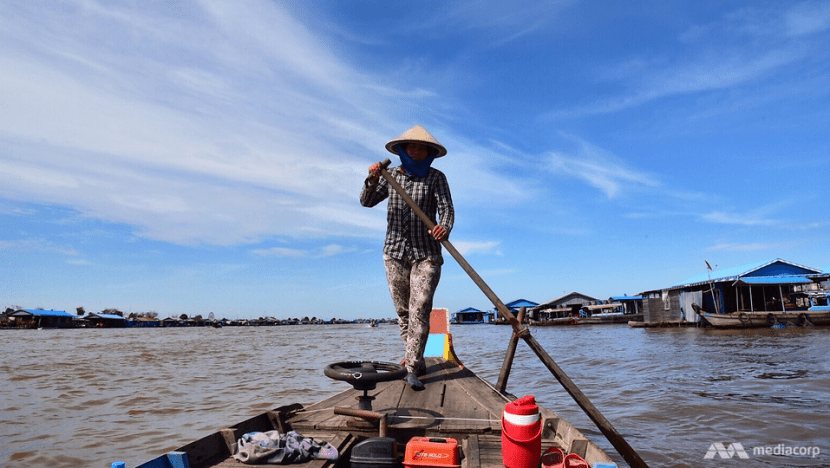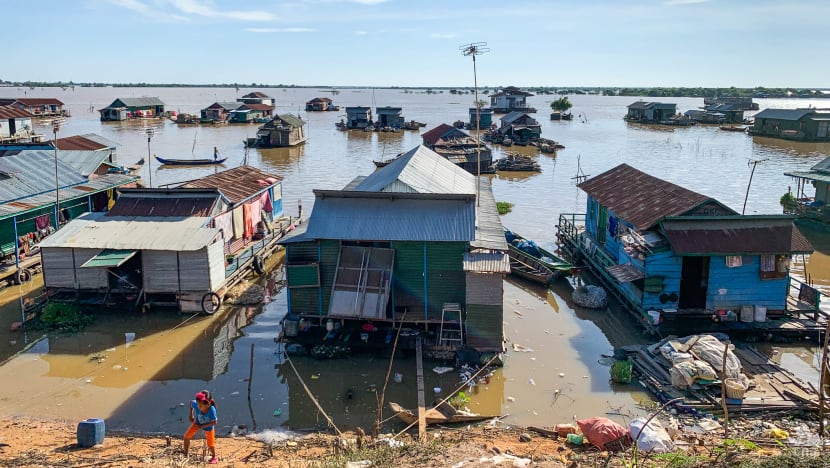Tonle Sap Lake, the beating heart of the Mekong basin, is on ‘life support’

BANGKOK: Southeast Asia’s largest freshwater lake reached historically low water levels at the end of last month, raising further concerns about the situation of a critically important ecosystem that feeds the reaches of the lower Mekong river basin.
Cambodia’s Tonle Sap, an expansive lake that can swell across a floodplain up to 20 times the size of Singapore during the monsoon season, is experiencing a third consecutive year of dire conditions. Station readings recorded a level of just 3.86m on Aug 31, nearly 1m lower than in 2020 and about half the normal average at this time of the year.
“At the end of August, the Tonle Sap reached a historical low at a time when the lake should be saturated with water and fish,” said Brian Eyler, a senior fellow and director of Energy, Water, and Sustainability, Southeast Asia at the Stimson Center.
“The lake was 80cm below its previous low - recorded in 2020 - and 4m below average. The beating heart of the Mekong is on life support,” he said.
Upstream dams, constructed along the upper Mekong river in Laos, Thailand, Myanmar and China - where the river is known as Lancang - withholding water are a contributing factor to the lower levels of flow into the lake.
Data from the Mekong Dam Monitor, an online platform that tracks indicators in the Mekong basin, shows that more than 12 billion cubic metres of water have been held back by 45 upstream dams since early July.
At some points along the Mekong river, 25 per cent of natural flow is missing, according to estimations from Eyes on Earth, using satellite data, physical river gauges and remote sensing.
These factors combined with below average rainfall have resulted in the unseasonal delay in the annual reverse of the Tonle Sap, a unique phenomenon where water starts to flow in an opposite direction due to flooding in the Mekong, drawing in huge amounts of fish into the lake system.
The lake acts as a natural storage that fills up and empties out in critical parts of the year. The more water that is stored upstream, the longer the delays to the Tonle Sap’s reversal.
Climate change is also creating havoc with the timing and intensity of the monsoon season, further disrupting the natural behaviours of the lake system and decimating agriculture in Cambodia.
Related:
“The Tonle Sap is the beating heart of Cambodia and the Mekong basin. The heart requires the annual flood pulse, which provides water, nutrients and sediments, to remain healthy,” said Gary Lee the Southeast Asia program director for International Rivers, a non-profit organisation.
Based on historical precedent, it is expected that the upstream dams will continue to hold water over the coming months, suggesting there is little likelihood of a quick fix for the situation in the Tonle Sap.
The Mekong River Commission (MRC), an inter-governmental body that aims to manage shared water resources, says it has known for some time that reservoirs along the Mekong would disrupt the timing and flood pulse. But conditions now are particularly worrying, a spokesperson for the MRC Secretariat told CNA.
“Over the last few years, we have seen both the increase in storage, reduced rainfall volume and timing of the monsoon rains affecting the volume and timing of the reverse flows into the Tonle Sap,” the spokesperson said.
“This, together with increased fishing pressures, pollution, reduced sediment transport and barriers to fish migration, poses an existential threat to the Lower Mekong River ecosystems.
“What we may be seeing now is a perfect storm of reduced and delayed rainfall, the total storage in the basin at the end of the previous dry season and the operations of that storage into the wet season.”

WHEN FISHERMEN CANNOT FISH
Aside from the environmental and ecological impacts, there are social impacts on the millions of people who rely on the Tonle Sap lake for their livelihoods and survival. The situation has been worsened by the COVID-19 pandemic.
Fishing is no longer the viable income-earner it once was, with locals forced to move to urban areas for low-paying and notoriously difficult construction work, according to Oudom Ham, an independent Cambodian consultant on climate change and river issues.
“Now they cannot even catch fish for their own consumption. They need to buy, which is ridiculous because they are fishermen but they cannot find fish for themselves,” he said.
The economics are not sustainable for those living close to the poverty line. A typical day’s earnings from fishing in the wet season previously could be close to double that working in the city.
“Fishermen compensate for depleting fish catches by taking out loans to help them get by but fishermen can’t do this in perpetuity. Something is going to break, either the livelihoods of millions or regional food security,” said Eyler of the Stimson Center.
At the same time, migrant workers who normally do construction jobs in neighbouring Thailand have been forced to return to their local communities, only to find that the situation is desperate.
Illegal fishing and the grabbing of land around flooded forest areas are compounding the problems.
“Now, resiliency is reducing. It’s surprising how quickly it’s happening, environmentally and socially,” said Oudom, the independent consultant.

GEOPOLITICAL DIMENSION
The geopolitical challenges are steep surrounding the management of the shared Mekong river resource.
China disagrees with the downstream assessments that its dams are responsible for the dropping water levels, blaming “interval rainfall” for the problems being experienced.
An inaugural dialogue on water security between the MRC and ASEAN last month could help boost protection for the river and place more scrutiny on the ways China utilises it.
There is increased urgency to come up with solutions that account for the views of regional stakeholders, given the recent observations.
“The downstream needs to negotiate with China to help return natural flow patterns to the Mekong,” Eyler said.
“China’s dams are reducing the annual flood pulse effect but so are scores of downstream dams in Laos, Vietnam, Cambodia, and Thailand. Restoring some semblance of natural flow is fraught with political difficulties but not impossible.”
While data sharing has increased, river campaigners want more transparency from Beijing.
“The major challenge or problem is being caused by the dams upstream, it has become very obvious,” Oudom said.
But the MRC has suggested that more studies will be needed to further assess the upstream impacts of major dam storage, as well as the effects of climate change.
It still sees merit in controlled releases of water by the mainstream dams “to minimise the water, food and energy risks, while mitigating against some of the adverse impacts of development”, its spokesperson said.
“The MRC is gradually swivelling towards these perspectives.”














